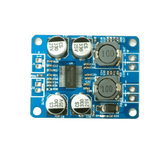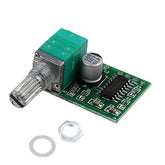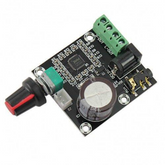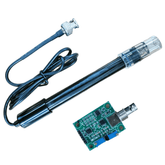Types of Amplifiers with their Workings
Summary
Discover the world of amplifiers in this informative blog. Starting with the definition of an amplifier, we explore various types, such as audio and power amplifiers, highlighting their unique characteristics. Furthermore, we delve into the crucial output properties that distinguish amplifiers, including gain, frequency response, and distortion. Finally, we explore the diverse applications of amplifiers across industries, emphasizing their significance in modern technology. Unveil the power and versatility of amplifiers.
What is an amplifier:
An amplifier is an electronic device that increases the strength of a weak electrical signal. It does this by taking in a small input signal and outputting a larger, amplified version of that signal. The primary function of an amplifier is to increase the amplitude of a weak signal, making it stronger and more useful. Amplifiers are used in a wide range of applications, from audio systems to wireless communication systems, and are an essential component of many electronic devices.
Types of Amplifiers:
There are several different types of amplifiers, each with its unique characteristics and uses. Some of the most common types of amplifiers include:
Voltage Amplifiers:
These amplifiers increase the voltage of an input signal. They are commonly used in audio systems to boost the output of a microphone or other low-level input device. Voltage amplifiers are designed to amplify a small AC or DC voltage signal, making it larger and more useful.

Current Amplifiers:
These amplifiers increase the current of an input signal. They are often used in power electronic systems, such as in motor controllers or power supplies. Current amplifiers are designed to increase the current flowing through a circuit, making it more powerful and useful.
Power Amplifiers:
These amplifiers increase the power of an input signal. They are commonly used in audio systems to drive large speakers or in wireless communication systems to transmit signals over long distances. Power amplifiers are designed to increase the power of a signal, making it stronger and more useful.

Transistor Amplifiers:
These amplifiers use transistors to amplify the input signal. They are widely used in electronic devices such as radios and televisions. Transistor amplifiers are designed to increase the strength of a signal by using a transistor to control the flow of current in a circuit.
Operational Amplifiers (Op-Amp):
These are voltage amplifiers with a very high voltage gain, high input impedance, and low output impedance. They are used in a wide range of applications such as active filters, oscillators, and signal processing. They are widely used in many electronic devices and systems.

Differential Amplifiers:
These amplifiers amplify the voltage difference between two input terminals while rejecting any common-mode signals that may be present. They are used in a wide range of applications such as instrumentation, data acquisition, and telecommunications.
The output properties of Amplifiers:
The output properties of amplifiers are determined by the type of amplifier and the specific design of the circuit. However, some common output properties include:
Gain:
This is the amount by which the amplifier increases the input signal. It is typically measured in decibels (dB). The gain of an amplifier is the ratio of the output signal to the input signal. It is a measure of the amplifier's ability to increase the strength of a signal.
Bandwidth:
This is the range of frequencies over which the amplifier can effectively amplify the input signal. The bandwidth of an amplifier is the range of frequencies over which the amplifier can amplify a signal with minimal distortion.
Distortion:
This is the number of unwanted variations or "noise" in the output signal. Distortion is a measure of the number of unwanted variations or noise in the output signal. It is an important parameter to consider when designing an amplifier circuit.
Noise:
This is an unwanted component of the output signal caused by the thermal motion of electrons in the amplifier's components. It is measured in terms of the noise voltage or noise current.
Input impedance:
This is the impedance of the input circuit of the amplifier. It is measured in ohms and is an important parameter to consider when connecting the amplifier to other devices in a circuit.
Output impedance:
This is the impedance of the output circuit of the amplifier. It is measured in ohms and is an important parameter to consider when connecting the amplifier to other devices in a circuit.
Efficiency:
This is the ratio of the output power to the input power. It is an important parameter to consider when designing an amplifier for a specific application.
Slew Rate:
This is the rate of change of the output voltage of the amplifier in response to a step input. It is measured in volts per microsecond and is an important parameter to consider when designing an amplifier for high-frequency applications.
Applications:
Amplifiers have a wide variety of applications in both industrial and consumer settings. Some examples include:
Audio systems:
Amplifiers are used to boost the output of microphones and other low-level input devices, as well as to drive large speakers. They are used in a wide range of audio applications such as home theaters, public address systems, and musical instruments.
Wireless communication systems:
Amplifiers are used to transmit signals over long distances, such as in cell phone towers and satellite communications systems. They are used in a wide range of wireless communication applications such as cellular telephones, Wi-Fi, and satellite communications.
Medical equipment:
Amplifiers are used in medical devices such as electrocardiograms (ECGs) and electroencephalographs (EEGs) to amplify weak biological signals. They are used in a wide range of medical applications such as monitoring vital signs, diagnosing diseases, and performing surgical procedures.
Automotive:
Amplifiers are used in cars to boost the audio signal and provide high-quality sound. They are used in a wide range of automotive applications such as car audio systems, navigation systems, and rearview cameras.
Industrial Control:
Amplifiers are used in control systems to increase the strength of control signals and improve system performance. They are used in a wide range of industrial applications such as process control, robotics, and machine control.
Test and Measurement Equipment:
Amplifiers are used in electronic test and measurement equipment such as oscilloscopes and signal generators to amplify weak signals for accurate analysis. They are used in a wide range of test and measurement applications such as laboratory research, product development, and quality control.
Military and Aerospace:
Amplifiers are used in military and aerospace applications such as radar systems and satellite communication to transmit and amplify signals over long distances. They are used in a wide range of military and aerospace applications such as navigation, communication, and defense systems.
Robotics:
Amplifiers are used in robotics to control the movement of motors and actuators, allowing robots to perform a wide range of tasks. They are used in a wide range of robotics applications such as manufacturing, assembly, and packaging.
Conclusion:
Amplifiers play a crucial role in various fields, from audio systems to telecommunications and beyond. By understanding what an amplifier is and the different types available, we can appreciate their versatility and wide range of applications. Whether you need to boost a weak signal, improve sound quality, or transmit data over long distances, amplifiers provide the necessary power and efficiency. With their ability to amplify and shape signals, amplifiers have become indispensable tools in modern technology. From the smooth melodies of music to the seamless communication in our interconnected world, amplifiers continue to enhance our experiences and drive innovation forward. So, whether you're an audio enthusiast, an engineer, or simply curious about the world of amplification, understanding the fundamentals and applications of amplifiers will undoubtedly empower you to make informed decisions and explore exciting possibilities.
If you appreciate our work don't forget to share this post and leave your opinion in the comment box.
Please do check out other blog posts about Popular electronics
Make sure you check out our wide range of products and collections (we offer some exciting deals!)
Frequently Asked Questions
1. What is an amplifier?
An amplifier is a crucial electronic device that plays a significant role in enhancing the voltage, current, or power of a signal. Its applications are diverse and widespread, ranging from wireless communications and broadcasting to audio equipment.
There exist two primary types of amplifiers: weak-signal amplifiers and power amplifiers. Weak-signal amplifiers find their primary use in wireless receivers, specifically designed to handle incredibly small input signals effectively. These amplifiers ensure that even the faintest signals are adequately amplified for further processing.
On the other hand, power amplifiers are employed in wireless transmitters, broadcast transmitters, and high-fidelity (hi-fi) audio equipment. Their purpose is to generate a sufficient level of power to drive speakers or transmit signals with ample strength.
Amplifiers can be classified based on their linearity and efficiency. Class A amplifiers, while the most linear type, tend to be less efficient. This means they consume more power but offer superior signal fidelity. Other amplifier classes prioritize efficiency over linearity, striking a balance between power consumption and signal accuracy.
The amplification capability of an amplifier is measured by its gain, which represents the ratio of output voltage, current, or power to the input. In simpler terms, gain quantifies how much the input signal is magnified by the amplifier, resulting in a larger output signal.
Amplifiers function by taking a weak input signal and increasing its strength to produce a more robust output signal. In the realm of audio equipment, amplifiers handle tiny electrical signals that encompass musical frequencies and amplitudes, intensifying their power to a level suitable for driving speakers. Furthermore, power amplifiers offer the flexibility to shape their overall sound characteristics through features like EQ controls, allowing users to customize their audio experience according to their preferences.
2. How an amplifier works?
Amplifiers function by taking an input signal from various sources like laptops, turntables, or CD players and producing a magnified replica of the original signal before transmitting it to the speakers. To carry out this process, amplifiers draw power from the mains electricity supply, which is directly routed to the amplifier's power supply unit.
Within the amplifier, the power supply unit performs a vital task of converting the alternating current (AC) from the mains into a direct current (DC) that flows in a single direction. This converted DC power is then directed to the transistor, a key component in the amplification process.
3. What are the 3 main properties of amplifier?
The properties of an amplifier can be defined by different parameters, but some of the main properties are as follows
- Gain: The gain of an amplifier determines its amplification. It is the ratio of output voltage, current, or power to input. The higher the gain, the more amplification an amplifier provides.
- Frequency response: The frequency response of an amplifier is the range of frequencies over which it can amplify a signal without distortion. It is usually expressed in Hertz (Hz).
- Sensitivity: The sensitivity of an amplifier is the minimum input signal required to produce a specified output signal. It is usually expressed in decibels (dB).
Other properties of amplifiers include distortion, bias stabilization, bandwidth, input and output impedance, phase shift, feedback, and power efficiency
The type of amplifier and its application can also affect its properties
The type of amplifier and its application can also affect its properties










